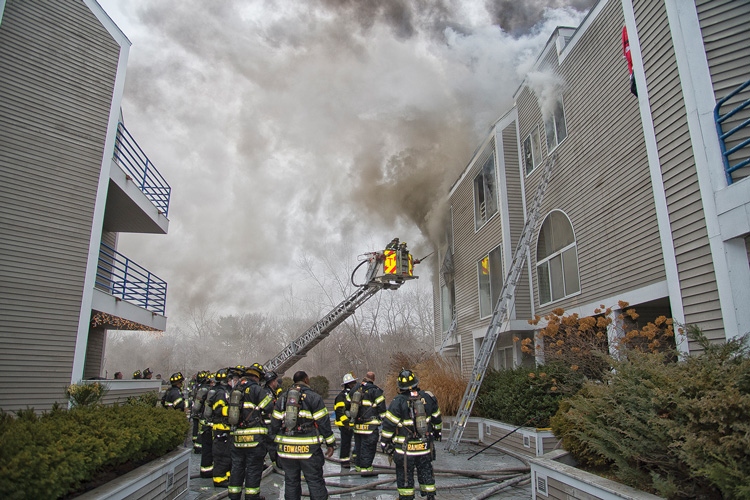
By Michael M. Dugan
You get a report of smoke showing from one of the new condo complexes in your town. It is most likely going to be a building of lightweight construction with lots of voids and concealed spaces that allow fire travel. Firefighters from the New Haven (CT) Fire Department encountered this type of building in December 2016. The building was a condo complex built on the river with limited access. This made getting apparatus and water to the building very difficult. The building also had an underground parking garage. Most of you have a complex or buildings of this type in your response area.
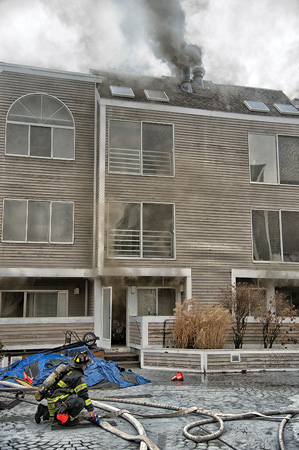 |
| (1) Smoke is seen from the first floor or ground floor, which is above a parking garage. This building might get confusing depending on what you call the floor levels. You can also see smoke showing from the vents at roof level. (Photos by Glenn Duda.) |
After a report of smoke showing from this building, the initial responding engine immediately transmitted a second alarm. That is always a good idea in a building of this type when you have a smoke condition. You are going to need more help.
One of the biggest issues you will face in a fire of this type is determining when the fire started and how far it has traveled. You need to identify the size and scope of the fire problem. This can be difficult and will be labor intensive. If you are from a small fire department or dealing with limited resources, you might immediately call for mutual aid. Once personnel start arriving on the scene, do a complete search and determine the origin of the fire. Do not put people above a fire until you have a line committed to that fire. Unfortunately, in a building of this type and construction, your search will have to start from the garage at the bottom level and through every level until you locate the origin. This will take a lot of personnel. You also need to address the immediate and known life hazards. Accounting for all occupants and residents can be difficult and even more so if the building is senior housing.
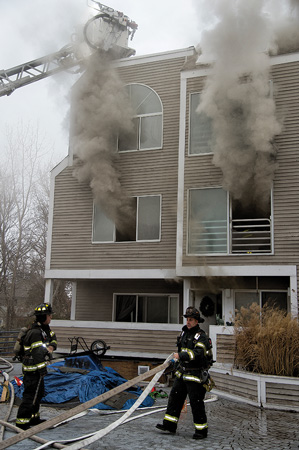 |
| (2) Smoke is showing from the second level and at the roof level, indicating a deep-seated fire in the void spaces. |
The first issue will be getting water on the fire and a water supply to the attack engine. These set-back complexes might have a limited water supply.
Another issue might be a dead-end main. If that is the case, the first-arriving engine company has hooked up to the closest hydrant or is being supplied by a unit on that closest hydrant; additional units should be directed to use a different water main. Know such information before a fire – ideally during the initial construction. If this is the case and an engine company responds on an additional alarm, hooks up to the single-source water main, and begins to supply a tower ladder or master stream, the pump operator might draw a vacuum because of water loss in the main. This could be extremely dangerous. Drilling beforehand with water flowing might indicate the problem and allow you to preplan and practice a solution.
 |
| (3) Members advance a handline from an exterior enclosed space to attempt to get water on the fire. |
The next issue will be the roof. Are you going to vent it? Under the current conditions, are you willing to put personnel on that roof? Succeeding levels of command will have to ask and answer these questions. Is the risk worth the reward? Is there a safe way to get off the roof quickly? Is there a second way off the roof, and can you get an aerial or ladder to it? Is there a safe area on an adjoining roof that is protected by a firewall? As you can see in photo 1, heavy smoke is showing from the vent pipes in the roof. This would indicate that the fire has spread to the roof space. If you have limited access, as was the case at this fire, you are going to have to be very sure to coordinate your tactics and actions.
 |
| (4) Members raise a Bangor ladder to the roof as a secondary means of egress. Knowledge of the building and its limited access makes it necessary to use different tactics and tools. |
At this fire, it was decided that the ladder would be a tower ladder for its offense capabilities. Therefore, another ladder is needed for the roof.
When was the last time you raised a 40- or 50-foot ground ladder? Was it in recruit school or Firefighter I class? If you have buildings in your response area that have these layouts and limited access, you had better be drilling on outside-the-box tactics and tricks that will work on these buildings. You can see from these photos that the New Haven Fire Department used these outside-the-box tactics at this fire.
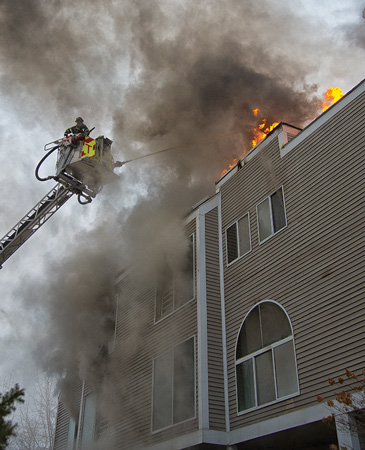 |
| (5) Fire is showing through the roof from vertical and horizontal fire spread. The tower ladder is used to knock down visible fire. |
In these photos, you can see an issue that can confuse many firefighters and officers. The garage space is a poured concrete parking space with the condo complex built above. For the operating forces, what is that space called? All members of the responding department and mutual-aid departments must be on the same page as far as labeling the building’s floors/levels. If you call the garage the first floor, then the living space starts on the second floor. If responders are not on the same page, their definitions of the first floor might differ. That could make fire attack and, more importantly, emergency messages confusing and potentially incorrect.
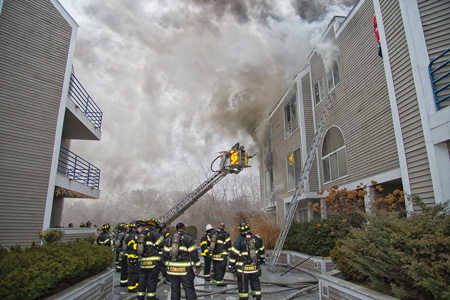 |
| (6) The tower ladder is operated to the top-floor windows, knocking down the gypsum ceiling and exposing fire in the attic space. |
The last issue in a building of this type and construction is the fire travel in enclosed voids. Once fire has entered the void spaces, you usually have a prolonged operation. These voids will allow fire that extends throughout the building horizontally and vertically. At this fire, members chased fire throughout the structure for hours.
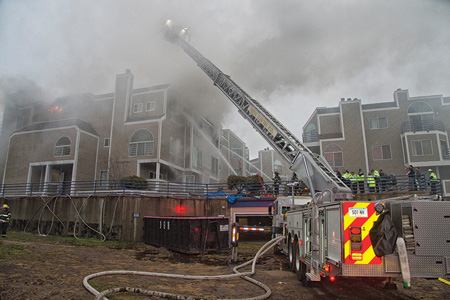 |
| (7) The tower ladder is positioned below the parking garage on this building. If you have a building of similar construction, know before a fire if your apparatus can drive into that area. Access and egress might be severely hampered. |
If your district or your mutual-aid district has one of these limited-access types of structures, preplanning and preparation are the keys to success and safety. The New Haven Fire Department had a very challenging fire that required many resources. Through command, training, and practice, all went as well as could be expected at a building of this type of construction.
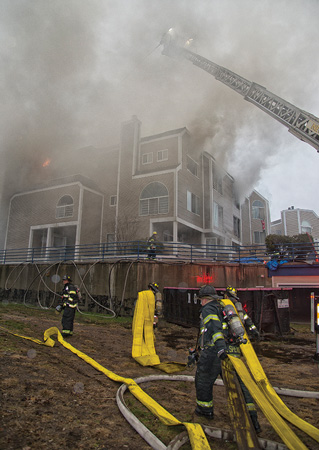 |
| (8) Members can be seen stretching large-diameter hose to the fire area. Water supply will be difficult and must be preplanned. |
MICHAEL M. DUGAN, a 42-year veteran of the fire service, is also a 27-year member of the Fire Department of New York (FDNY), where he retired as the captain of Ladder Company 123 in Crown Heights, Brooklyn. As a lieutenant, he served in Ladder Company 42 in the South Bronx. While assigned as a firefighter in Ladder Company 43, in Spanish Harlem, he received the James Gordon Bennett medal in 1992 and the Harry M. Archer Medal in 1993, FDNY’s highest award for bravery. He was a volunteer firefighter in Halesite, New York. He lectures on truck company operations, building construction, size-up, and today’s fire service. He is a member of the FDIC International and Fire Engineering editorial advisory boards.
Flat-Roof Fires in Three- to Six-Story Apartment Buildings
BIG TRUCK, SMALL TOWN
Garden Apartment and Townhouse Fires
Fire Engineering Archives

